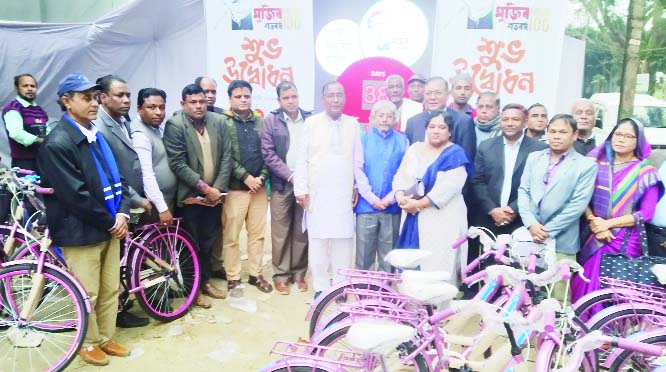
Md Mosabbir Ali back from Kamalgonj :
Class-eight student Goyna Sawtal who lives in Lakhai Tea Garden in Moulvibazar’s Sreemangal Upazila, has to cover 12- kilometer from home to Raynar High School & College on foot, returning the same way. She didn’t always manage but now-a-days Goyna reaches school more regularly because she got a bicycle.
On last 7th February this year, the Indian High Commission distributed 150 bicycles to poor students including mostly female students to reduce dropout rates and help students from distant homes reach class.
“I’m really happy to get a bicycle,” said , Goyna. “I wasn’t very interested in attending school before because of the long walk. Now it’s quite convenient. I will take good care of my bicycle.”
“Having a bicycle encourages me to study properly,” said another recipient Suma Nayek, a class-nine student of Kamudpur High School in Kamalganj Upazila.
“Never again will transport problems prevent me from attending school.”
Vandarigaon High School’s Headmaster, Abdul Matin, said , Indian High Commission’s bicycle initiative has been encouraging education for girls.
“Since the bicycle distribution, the attendance of female students at our school has become more regular.”
Krishan Bhumij, General Secretary , Sreemangal Yoga Academy, also sees merit in the scheme.
“Parents are more comfortable sending their daughters to school now,” he says, “and that makes it easier for them to enrol in high school and ultimately pursue higher education too. The girls’ dropout rate at local schools is decreasing because of the bicycles.”
“We allocated the bicycles to meritorious students and to disadvantaged schoolgirls from backward people including the tea gardens,” said Mr L Krishnamurthy, Assistant High Commissioner of India. He also said. the use of bicycles will be monitored to assess the longer- term success of the scheme.
They offer the girls a sense of pride in themselves and their education, and can work to underline the importance of schooling for women across remote communities.
“At first it was difficult to convince some guardians that their daughters needed school,” L Krishnamurthy recalled . “The benefits of schooling for girls are now better appreciated. When locals see a large number of female students cycling together, it helps promote the idea that girls pursuing education is both usual and of value.
Class-eight student Goyna Sawtal who lives in Lakhai Tea Garden in Moulvibazar’s Sreemangal Upazila, has to cover 12- kilometer from home to Raynar High School & College on foot, returning the same way. She didn’t always manage but now-a-days Goyna reaches school more regularly because she got a bicycle.
On last 7th February this year, the Indian High Commission distributed 150 bicycles to poor students including mostly female students to reduce dropout rates and help students from distant homes reach class.
“I’m really happy to get a bicycle,” said , Goyna. “I wasn’t very interested in attending school before because of the long walk. Now it’s quite convenient. I will take good care of my bicycle.”
“Having a bicycle encourages me to study properly,” said another recipient Suma Nayek, a class-nine student of Kamudpur High School in Kamalganj Upazila.
“Never again will transport problems prevent me from attending school.”
Vandarigaon High School’s Headmaster, Abdul Matin, said , Indian High Commission’s bicycle initiative has been encouraging education for girls.
“Since the bicycle distribution, the attendance of female students at our school has become more regular.”
Krishan Bhumij, General Secretary , Sreemangal Yoga Academy, also sees merit in the scheme.
“Parents are more comfortable sending their daughters to school now,” he says, “and that makes it easier for them to enrol in high school and ultimately pursue higher education too. The girls’ dropout rate at local schools is decreasing because of the bicycles.”
“We allocated the bicycles to meritorious students and to disadvantaged schoolgirls from backward people including the tea gardens,” said Mr L Krishnamurthy, Assistant High Commissioner of India. He also said. the use of bicycles will be monitored to assess the longer- term success of the scheme.
They offer the girls a sense of pride in themselves and their education, and can work to underline the importance of schooling for women across remote communities.
“At first it was difficult to convince some guardians that their daughters needed school,” L Krishnamurthy recalled . “The benefits of schooling for girls are now better appreciated. When locals see a large number of female students cycling together, it helps promote the idea that girls pursuing education is both usual and of value.

